
A luge is a small one- or two-person sled on which one sleds supine (face-up) and feet-first. A luger begins seated, propelling themselves initially from handles on either side of the start ramp, then steers by using the calf muscles to flex the sled's runners or by exerting opposite shoulder pressure to the pod. Racing sleds weigh 21–25 kg (46–55 lb) for singles and 25–30 kg (55–66 lb) for doubles. Luge is also the name of an Olympic sport that employs that sled and technique.

Skeleton is a winter sliding sport in which a person rides a small sled, known as a skeleton bobsled, down a frozen track while lying face down and head-first. The sport and the sled may have been named from the bony appearance of the sled.
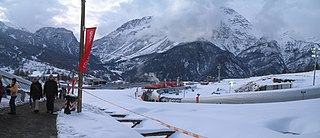
Cesana Pariol was the venue for bobsleigh, luge and skeleton during the 2006 Winter Olympics in Turin, Italy. The track, built for the games, is located in Cesana. The venue holds approximately 7,130 spectators, of whom 3,624 are seated.

The International Luge Federation (French: Fédération Internationale de Luge de Course(FIL); German: Internationaler Rennrodelverband) is the main international federation for all luge sports. Founded by 13 nations at Davos, Switzerland in 1957, it has members of 53 national luge associations as of 2009 and is based in Berchtesgaden, Germany. In reaction to the 2022 Russian invasion of Ukraine, in March 2022 the FIL banned all Russian athletes, coaches, and officials from its events, suspended all Russian officials appointed to its Commissions and Working Groups, and deemed Russia ineligible to host any of its events.
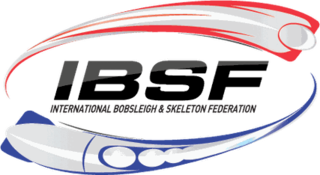
The International Bobsleigh and Skeleton Federation (IBSF) is the international sports federation for the sliding sports of Bobsleigh and Skeleton. It was founded on 23 November 1923 by the delegates of Great Britain, France, Switzerland, Canada, and the United States at the meeting of their first International Congress in Paris, France. In June 2015, it announced a name change from FIBT to IBSF. The federation's headquarters are in Lausanne, Switzerland.

The Oberhof bobsleigh, luge, and skeleton track is a venue used for bobsled, luge and skeleton located in Oberhof, Germany.

The Altenberg bobsleigh, luge, and skeleton track is a venue in Germany for bobsleigh, luge, and skeleton. Located in Saxony in eastern Germany, it is northwest of Altenberg, near the border with the Czech Republic.

The Königssee bobsleigh, luge, and skeleton track is a venue in Germany for bobsleigh, luge and skeleton, located in Schönau am Königssee, Bavaria, near Königssee and the border with Austria. Completed 56 years ago in 1968, it is the first permanent, artificially refrigerated bobsleigh, luge, and skeleton track in the world. In July 2021, the track was severely damaged by the floods that affected the European continent, and is currently under reconstruction.
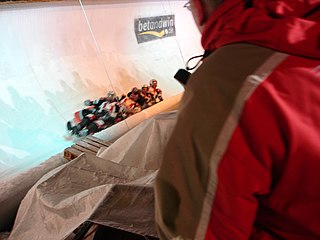
The Olympic Sliding Centre Innsbruck is a venue for bobsleigh, luge and skeleton located in Igls, Austria. The most recent version of the track was completed in 1975 and is the first permanent, combination artificially refrigerated bobsleigh, luge, and skeleton track, serving as a model for other tracks of its kind worldwide. It hosted the bobsleigh, luge, and skeleton competitions for the 2012 Winter Youth Olympics.

The Mt. Van Hoevenberg Olympic Bobsled Run is a venue for bobsleigh, luge and skeleton in the United States, located at the Lake Placid Olympic Sports Complex in Lake Placid, New York. This venue was used for the 1932 and 1980 Winter Olympics and for the only winter Goodwill Games in 2000. The track hosted both the first FIBT World Championships and FIL World Luge Championships held outside of Europe, doing so in 1949 and 1983. The third and most recent version of the track was completed in 2000. In 2010 the bobsled track was listed on the National Register of Historic Places.
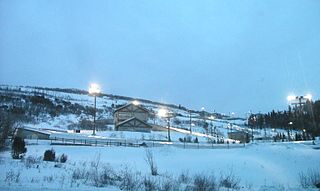
The Utah Olympic Park Track is a bobsleigh, luge, and skeleton track in the United States, located in the Utah Olympic Park near Park City, Utah. During the 2002 Winter Olympics in nearby Salt Lake City, the track hosted the bobsleigh, luge, and skeleton events, and is expected to reprise these roles for the 2034 Winter Olympics. Today the track still serves as a training center for Olympic and development level athletes and hosts numerous local and international competitions. It is one of two national tracks; the other is at Mt. Van Hoevenberg near Lake Placid, New York.

The Spiral is a bobsleigh, luge, and skeleton track located in Iizuna village, located north of Nagano, Japan. Used for the bobsleigh and luge competitions for the 1998 Winter Olympics, it is the first permanent bobsleigh, luge, and skeleton track in Asia and the first of its type in the world with two or more uphill sections. It is officially referred to as the Nagano Bobsleigh-Luge Park in Japan.
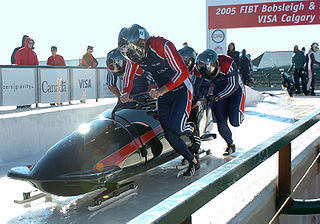
The Canada Olympic Park bobsleigh, luge, and skeleton track is a bobsleigh, luge, and skeleton track located in Calgary, Alberta. Part of Canada Olympic Park, it hosted the bobsleigh and luge competitions at the 1988 Winter Olympics. This track is one of only two of its type in the world to be featured in a non-documentary film when it was part of the 1993 American film Cool Runnings which loosely followed the Jamaican Bobsled Team during their competition in bobsleigh at the 1988 Games.

The Whistler Sliding Centre is a Canadian bobsleigh, luge, and skeleton track located in Whistler, British Columbia, that is 125 km (78 mi) north of Vancouver. The centre is part of the Whistler Blackcomb resort, which comprises two ski mountains separated by Fitzsimmons Creek. Located on the lowermost slope of the northern mountain, Whistler Sliding Centre hosted the bobsleigh, luge, and skeleton competitions for the 2010 Winter Olympics.

Lillehammer Olympic Bobsleigh and Luge Track is a bobsleigh, luge and skeleton track located at Hunderfossen in Fåberg, Norway, 15 kilometers (9 mi) north of the town center of Lillehammer. It was completed in 1992 for the 1994 Winter Olympics, where it hosted the bobsleigh events and luge events. It has since also hosted the FIBT World Championships 1995 in skeleton and the FIL World Luge Championships 1995, and hosted 2016 Winter Youth Olympics.
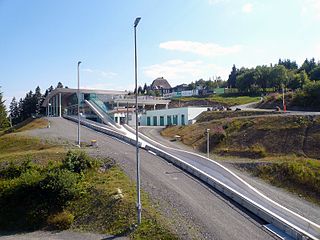
The Winterberg bobsleigh, luge, and skeleton track is a bobsleigh, luge, and skeleton track located in Winterberg, Germany. It is the only track of its kind in the world with a turn that has corporate sponsorship with turn seven being sponsored by Veltins, a German brewery which has its headquarters located in neighboring Meschede.

The Paramonovo bobsleigh, luge, and skeleton track is a bobsleigh, luge, and skeleton located in Paramonovo, Russia, 60 kilometers (37 mi) outside of Moscow.

The Olympic Sliding Centre is a bobsleigh, luge, and skeleton track that is located in Daegwallyeong, Pyeongchang, South Korea. The centre is located between the Alpensia and Yongpyong Resort. The venue is one of only two operating sliding facilities in Asia, along with the Spiral in Japan.
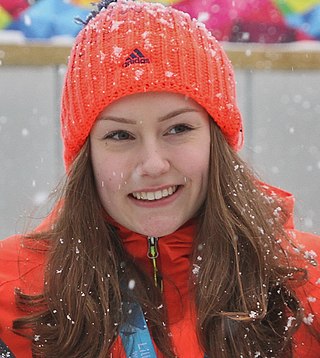
Laura Nolte is a German bobsleigh pilot, who began competing for the national team in 2015 and won the gold medal in the two-woman bobsleigh event at the 2022 Winter Olympics, becoming the youngest in bobsleigh history to win the title. In 2023 she has become the first European to win the Monobob World Champion title at the Sankt Moritz World Championships, while being also the winner of the 2023 European Monobob Champion title in Altenberg, Germany. In 2021, she won the gold medal in the two-woman event at the IBSF European Championships 2021 held in Winterberg, Germany. In the same season, she also won the gold medal in the two-woman event at the IBSF Junior World Championships 2021 held in St. Moritz, Switzerland.

South Korea competed at the 2022 Winter Olympics in Beijing, China, from 4 to 20 February 2022.




















